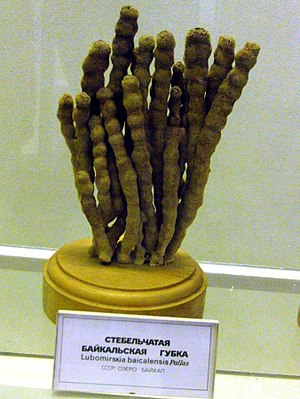Lubomirskia baicalensis
| Lubomirskia baicalensis | ||||||||||||
|---|---|---|---|---|---|---|---|---|---|---|---|---|

Lubomirskia baicalensis |
||||||||||||
| Systematics | ||||||||||||
|
||||||||||||
| Scientific name | ||||||||||||
| Lubomirskia baicalensis | ||||||||||||
| ( Pallas , 1776) |
Lubomirskia baicalensis is an endemic species of sponge from Lake Baikal (freshwater). It belongs to the order of the Haplosclerida from the class of horned silica sponges .
description
Lubomirskia baicalensis forms columnar, branched structures that have grown on a narrow, encrusting base on the hard substrate of the water bed; specimens are rarely found on soft substrate. The "branches" usually reach 30 to 60 centimeters, exceptionally up to one meter in height. They are forked dichotomously and rounded at the tip (distal). Their shape is not regular, they can be cylindrical or flattened, sometimes fan-shaped with an increasing width, their thickness ranges from about one to about four centimeters. The consistency is elastic due to spongin fibers, the surface rough due to protruding spicules. The Oscula reach three to four millimeters in diameter, they sit in several heaped pockets, which are scattered over the surface of the sponge, rarely standing in rows, with a distance of about one to three centimeters. The larger skeletal needles (megasclerae) reach 145 to 233 micrometers in length, they are cylindrical to spindle-shaped with pointed ends on both sides, their surface is usually rough due to small teeth, more rarely it can be smooth. Neither microsclera nor gemmulae occur.
The flagellum of Lubomirskia baicalensis is turned into a small pit. The kinetosome is anchored with microtubules that run perpendicular to it .
Ecology and way of life
The species grows over stones and dead wood of the littoral and sublittoral, about three to four, up to about 50, with a focus in about five to eight meters depth, along the entire sea coast. While hard substrates are clearly preferred, structures that are rounded on both sides and are lying on soft substrates such as sand or mud are less common, which are assumed to be due to broken off individuals that continue to grow here. The species is very common in the lake and is one of the dominant colonists of the shore zone, it can reach a biomass of one kilogram fresh weight per square meter of lake floor. Lubomirskia baicalensis has due to symbiotic living zoochlorella a bright green color. It provides habitat for the gammarids Brandtia parasitica , Eulimnogammarus cruentus and E. grandimanus as well as numerous copepods , annelids and turbellarians .
Phylogeny, Taxonomy and Systematics
The species was first described by the famous naturalist Peter Simon Pallas as Spongia baikalensis , it was declared a type species of the genus Lubomirskia Dybowski by PDRezvoi in 1880. The genus, like the entire Lubomirskiidae family, is endemic to Lake Baikal and includes three other species. According to more recent studies, mainly based on the comparison of homologous DNA sequences, the species combined in the Lubomirskiidae turned out to be a monophyletic taxon, but their sister species was the widespread freshwater sponge Ephydatia muelleri . This suggests that the family first differentiated itself from this species (or a closely related ancestor with similar morphology) in the form of adaptive radiation in Lake Baikal . Using the methods of the molecular clock , a period about 2.3 million years ago is reconstructed. According to the results, the genus Lubomirskia itself is probably not a monophyletic unit.
Further literature
- ED Demidov, VB Borodin, D. L Stom: Photosynthesis of Zoochlorella Cells Isolated from Fresh-Water Baikal Sponge Lubomirskia baicalensis . In: Russian Journal of Plant Physiology . tape 40 , no. 5 , 1993, p. 698-703 .
Individual evidence
- ↑ a b Renata Manconi & Roberto Pronzato: suborder Spongillina Subord. nov .: Freshwater Sponges. In John NA Hooper and Rob WM Van Soest (editors): Systema Porifera: A Guide to the Classification of Sponges. Kluwer Academic / Plenum Publishers, New York, 2002. Pages 970-971.
- ↑ a b Peter Röpstorf, Joachim Reitner: Morphology of some freshwater porifera (Baikalospongia bacillifera, Lubomirskia baicalensis, Swartschewskia papyracea) of Lake Baikal (Siberia, Russia) . In: Berlin geoscientific treatises . tape 13 , 1994, pp. 507-525 ( PDF ).
- ↑ Valeria Itskovich, Andrey Gontcharov, Yoshiki Masuda, Tsutomu Nohno, Sergey Belikov, Sofia Efremova, Martin Meixner, Dorte Janussen (2008): Ribosomal ITS Sequences Allow Resolution of Freshwater Sponge Phylogeny with Alignments Guided by Secondary Structure Prediction. Journal of Molecular Evolution 67: 608-620. doi : 10.1007 / s00239-008-9158-5
- ↑ Olga Maikova, Igor Khanaev, Sergei Belikov, Dmitry Sherbakov (2014): Two hypotheses of the evolution of endemic sponges in Lake Baikal (Lubomirskiidae). Journal of Zoological Systematics and Evolutionary Research 53 (2): 175-179. doi : 10.1111 / jzs.12086